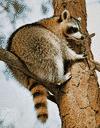- raccoon
-
1. a nocturnal carnivore, Procyon lotor, having a masklike black stripe across the eyes, a sharp snout, and a bushy, ringed tail, native to North and Central America and introduced elsewhere for its valuable fur.2. the thick, brownish-gray fur of this animal, with gray, black-tipped guard hairs.3. any of various related animals of the genus Procyon, of Central American islands, some now rare.[1600-10, Amer.; < Virginia Algonquian (E sp.) aroughcun]
* * *
or ringtailAny of seven species of omnivorous, nocturnal carnivores (genus Procyon, family Procyonidae) characterized by a bushy, ringed tail and a black mask on the face.The North American raccoon (P. lotor) has a stout body, short legs, pointed muzzle, and small erect ears. It is 30–36 in. (75–90 cm) long, including the 10-in. (25-cm) tail, and weighs over 22 lb (10 kg). The shaggy, coarse fur is iron-gray to blackish. The feet resemble slender human hands. Raccoons eat arthropods, rodents, frogs, berries, fruit, and plants; in towns and cities they thrive on garbage. They prefer woods near water and usually live in hollow trees. The crab-eating raccoon (P. cancrivorus) of South America is similar but has coarser fur. North American raccoon (Procyon lotor).Leonard Lee Rue III
North American raccoon (Procyon lotor).Leonard Lee Rue III* * *
▪ mammalalso called ringtailany of seven species of nocturnal mammals characterized by bushy, ringed tails. The most common and well-known is the North American raccoon (Procyon lotor), which ranges from northern Canada and most of the United States southward into South America. It has a conspicuous black “mask” across the eyes, and the tail is ringed with five to ten black bands.A stout animal with short legs, a pointed muzzle, and small erect ears, the North American raccoon is 75 to 90 cm (30 to 36 inches) long, including the 25-cm (10-inch) tail. Weight is usually about 10 kg (22 pounds) or less, although large males may grow to more than 20 kg. Those living in northern regions are larger than their southern counterparts. The North American raccoon's fur is shaggy and coarse, and its colour is iron-gray to blackish with brown overtones. Southern raccoons are typically more silver, with northern “coons” tending toward blond or brown.Like all raccoons, the North American raccoon is an intelligent and inquisitive animal. The hairless front feet are highly dexterous and resemble slender human hands, the hind feet being thicker and longer. Although classified as a carnivore, the raccoon is omnivorous, feeding on crayfish and other arthropods, rodents, frogs, and fruit and other plant matter, including crops. Raccoons are mistakenly believed to “wash” their food before eating it if water is available. This misconception arises from their habit of searching for food in or near water and then manipulating it while eating.Raccoons adapt extremely well to human presence, even in towns and cities, where they den in buildings and thrive on a diet of garbage, pet food, and other items available to them. As availability of food is the primary factor affecting the abundance of raccoons, the highest population densities are often found in large cities. In the wild raccoons live in a wide variety of forest and grassland habitats. Most often found in proximity to water, they are also proficient swimmers. They climb readily and usually den in riverbanks, hollow trees or logs, or abandoned beaver lodges.Raccoons overcome winter food shortages by becoming dormant (dormancy). This period may last from a few days, in response to occasional southern cold spells, to four to six months at northern latitudes. Northern raccoons are able to do this by accumulating large amounts of body fat during the late summer and autumn. Most will double their springtime body weight in order to provide themselves with enough energy to sleep through the winter.In early spring males mate with more than one female. Annual litters contain one to six (usually three or four) young, born in late spring after a gestation period of 60–73 days. The female takes a keen interest in her young and cares for them for about a year, even though the young begin hunting food and are weaned at about two months. In captivity raccoons can live up to 20 years, but few survive beyond 5 in the wild. Their large size and vigorous defense sometimes enable them to fend off predators such as bobcats, coyotes, and mountain lion (puma)s. Most deaths, however, are caused by humans and disease, especially canine distemper, parvovirus, and rabies. Rabies is especially significant in the eastern United States, where raccoons surpassed skunks in 1997 as the most frequent vector of the disease. Vaccine-laden bait has been air-dropped in Canada in an effort to stop the spread of rabies.Because of its fondness for eggs, nestlings, corn, melons, and garbage, the raccoon is unwelcome in some areas. It is still hunted (often with hounds) and trapped for its fur and flesh. The North American raccoon played an important role in the North American fur industry during the 19th century. In the early decades of the 20th century, raccoon coats were de rigueur for the sporting set. As a result of the fur's value, raccoons were introduced to France, The Netherlands, Germany, and Russia, where they have become a nuisance. In the latter portion of the 20th century, raccoons expanded their range northward in Canada, likely because of conversion of forest to agricultural land. Warmer temperatures and less-severe winters would enable raccoons to extend their range even farther.The crab-eating raccoon (P. cancrivorus) inhabits South America as far south as northern Argentina. It resembles the North American raccoon but has shorter, coarser fur. The other members of genus Procyon are not well known. Most are tropical and probably rare. They are the Barbados raccoon (P. gloveralleni), the Tres Marías raccoon (P. insularis), the Bahaman raccoon (P. maynardi), the Guadeloupe raccoon (P. minor), and the Cozumel raccoon (P. pygmaeus). Raccoons belong to the family Procyonidae (procyonid), along with the olingos, the cacomistle, and the kinkajou.Serge Lariviere* * *
Universalium. 2010.
